Expert's Rating
Pros
- Straightforward way to record over-the-air TV
- Plays and records encrypted ATSC 3.0 channels
- Product is regularly improving through software updates
Cons
- Tuner management can get tricky
- No visual preview to help skip over commercials
- Can’t sort series recordings by season
Our Verdict
The ZapperBox M1 is a pricey but easy-to-use over-the-air DVR with full NextGen TV support.
Price When Reviewed
This value will show the geolocated pricing text for product undefined
Best Pricing Today
Best Prices Today: ZapperBox M1
In a battle of over-the-air DVRs, the ZapperBox M1 has essentially won by default.
Amazon abandoned its Fire TV Recast DVR in 2022. TiVo discontinued its Edge over-the-air DVR earlier this year. Tablo’s overhauled 4th-gen DVR is promising, but buggy. Channels DVR, while great, requires a complex hardware setup.
All that leaves Bitrouter’s ZapperBox M1 as the only plug-and-play option with modern DVR features such as series recordings and a 14-day TV guide. It’s also the only DVR that can record encrypted ATSC 3.0 channels as of this writing. While it’s pricey at $275 for a dual-tuner model—plus $5 per month or $30 per year for a DVR subscription—its a worthwhile investment for cord cutters who want a future-proof way to record broadcast channels from an antenna.
The ZapperBox M1 has evolved from a beta product into a solid, plug-and-play DVR, one that can record any over-the-air channel, encrypted or not.
What’s in the ZapperBox
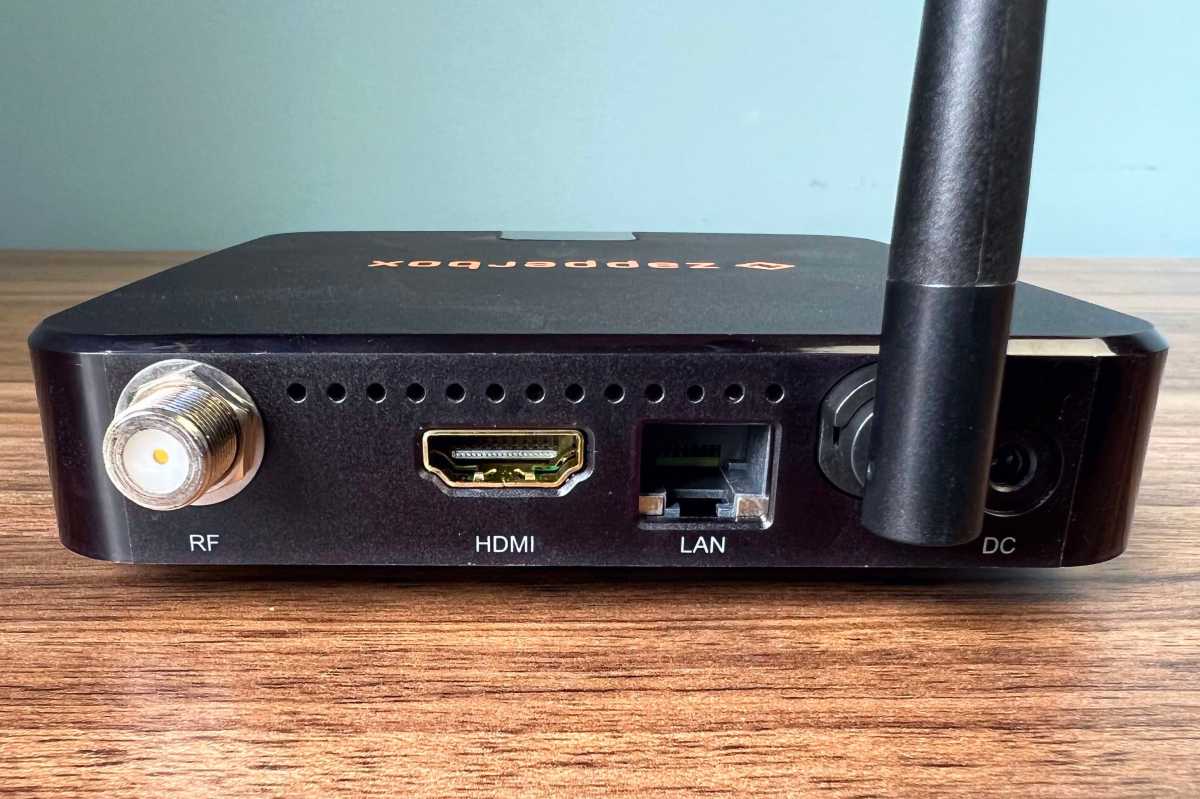
The ZapperBox has a coax input that works with any antenna.
Jared Newman / Foundry
The ZapperBox M1 is a rectangular puck roughly the size of high-end streaming boxes such as the Roku Ultra and Apple TV 4K. Connect any over-the-air antenna and plug the box into your TV’s HDMI port, and you can start watching live TV.
DVR requires the aforementioned subscription and an internet connection—via either Wi-Fi or hardwired ethernet—plus a microSD card or a USB drive for storage. The ZapperBox requires at least 128GB of storage, which will record roughly 25 to 50 hours depending on video quality; Bitrouter has confirmed support for hard drives up to 8TB.
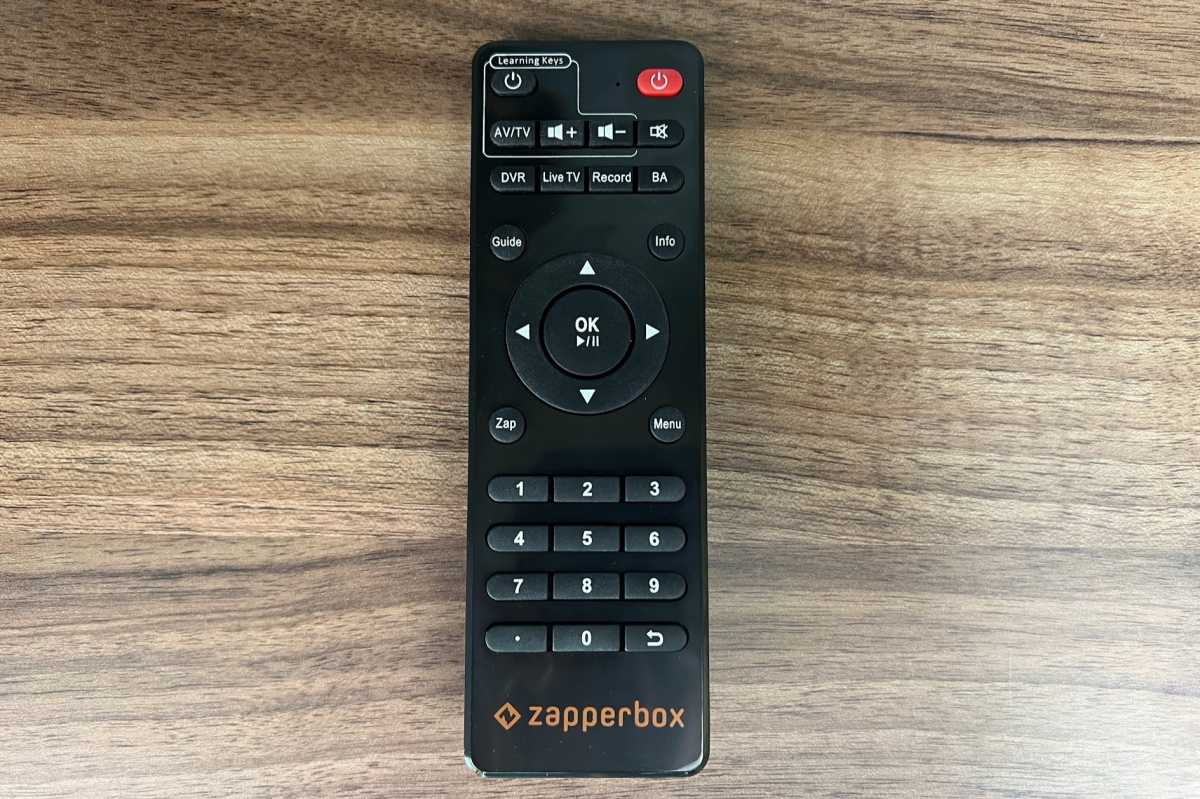
Jared Newman / Foundry
The ZapperBox comes with its own remote, which you must use in place of your TV’s remote, and it uses infrared, which requires line-of-sight to the box. A set of four programmable keys is just enough for TV power, volume, and input-switching, though you can also have them control any function from any other infrared remote. You can also program a universal remote to control the ZapperBox itself.
This review is part of TechHive’s in-depth coverage of the best over-the-air DVRs.
Surfing the airwaves
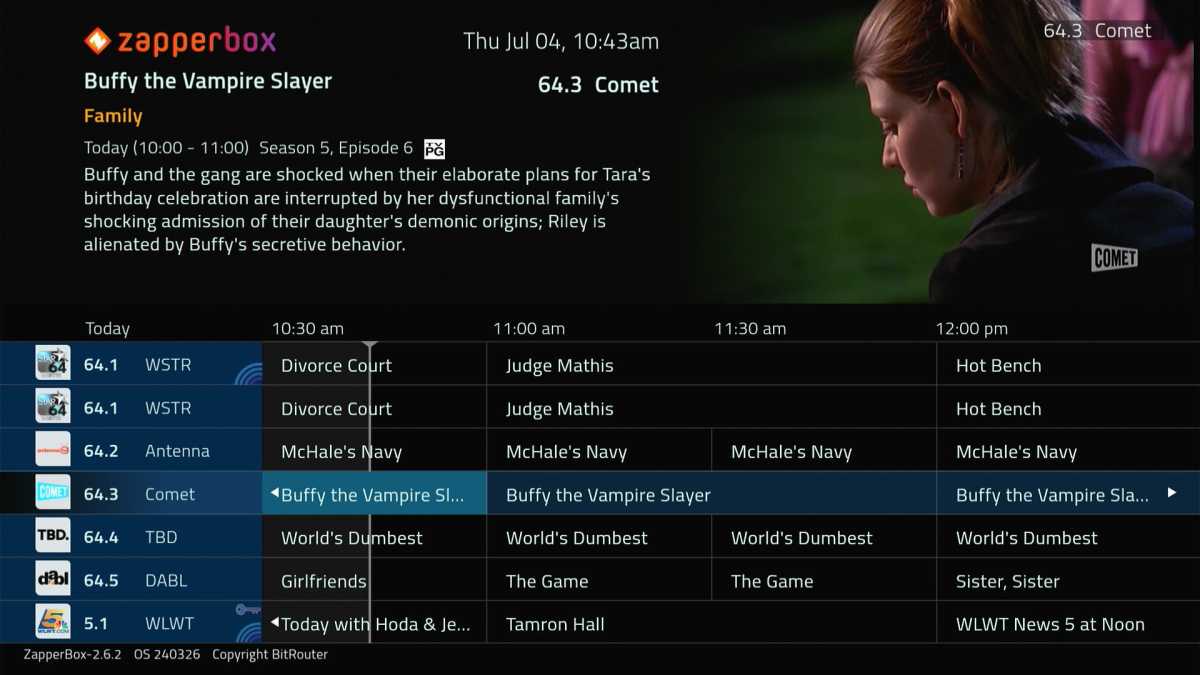
Jared Newman / Foundry
The main way you’ll interact with the ZapperBox is through its grid guide, which is accessible through the remote’s Guide button.
It’s a pretty nice guide, displaying live TV in a small window while you browse. A description of the currently-highlighted program appears up top, and the listings underneath are easy to read without being overwhelmingly dense. ATSC 3.0 channels are highlighted with a wave icon, and you can hide unwated channels through a settings menu. Pressing the remote’s “Zap” button lets you page up or down through the guide and skip ahead to future dates.
While viewing live TV, you can click up or down to flip through channels, click the back button to load the previous channel, and hit the Info button for details on the program and broadcast quality. You can also pause, fast forward, and rewind through live TV starting from when you tuned in, no subscription necessary.
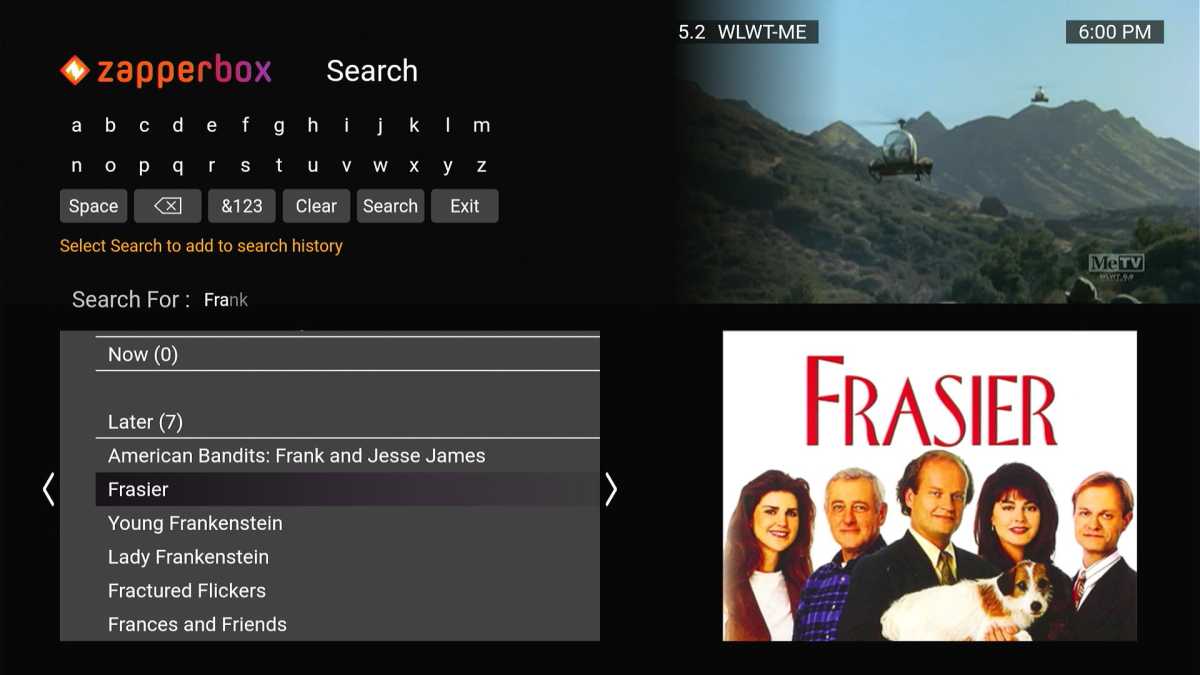
ZapperBox’s search menu can help find upcoming shows to record.
Jared Newman / Foundry
Clicking the ZapperBox’s Menu button reveals a few extra features, including a search function for live or upcoming programs, a settings menu, and access to a built-in YouTube app. (While the box is based on Android, it doesn’t offer any other streaming functionality.)
The system works well overall, but it feels sluggish compared to modern streaming players. Live channels take around seven seconds to load—or a few seconds longer for encrypted ATSC 3.0 channels—and there’s a hint of lag between clicking the remote and seeing a response on the screen.
DVR features
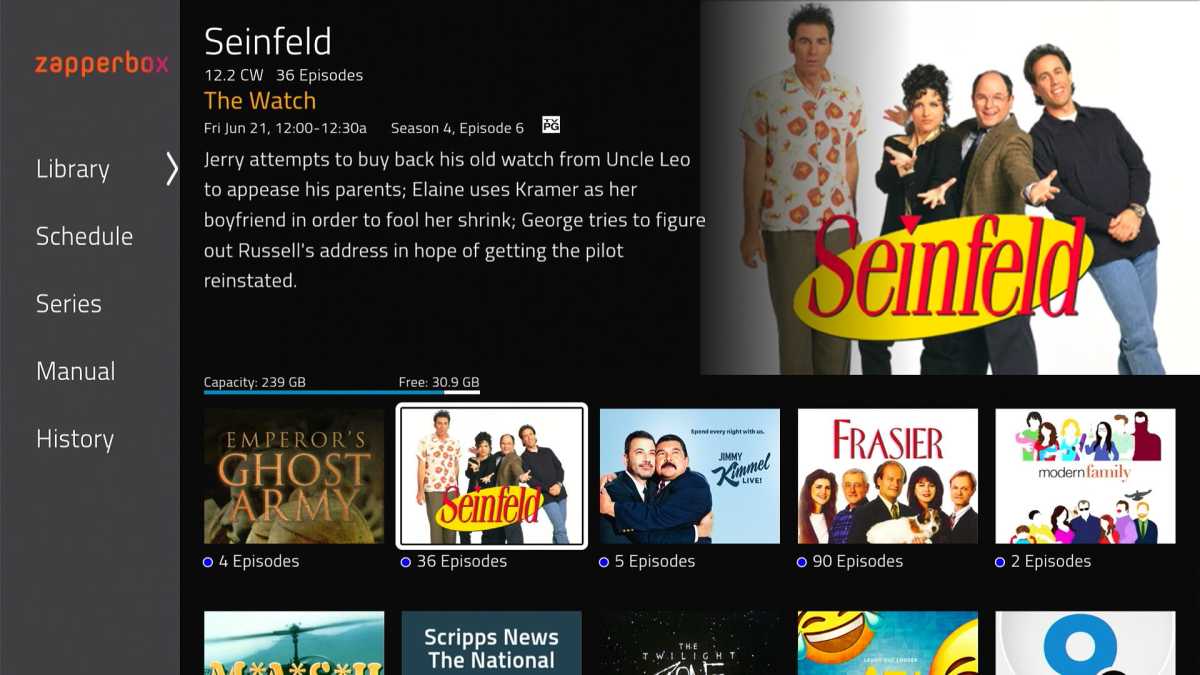
Jared Newman / Foundry
The ZapperBox M1’s DVR support has come a long way since our initial review, when it was still in beta, though it still feels like a work in progress.
As before, you can set up series recordings from the grid guide or search menu, but now you can also avoid recording reruns and set up start and stop buffer times, which are helpful for dealing with sporting events. ZapperBox has also overhauled its Library menu to include cover art and episode descriptions, giving the interface a more polished appearance.
Some frustrations remain, though. You can’t yet automatically discard recordings after a set period of time, and recordings for each show are sorted by air date, with no way to jump between seasons. This often results in series recordings being out of order.
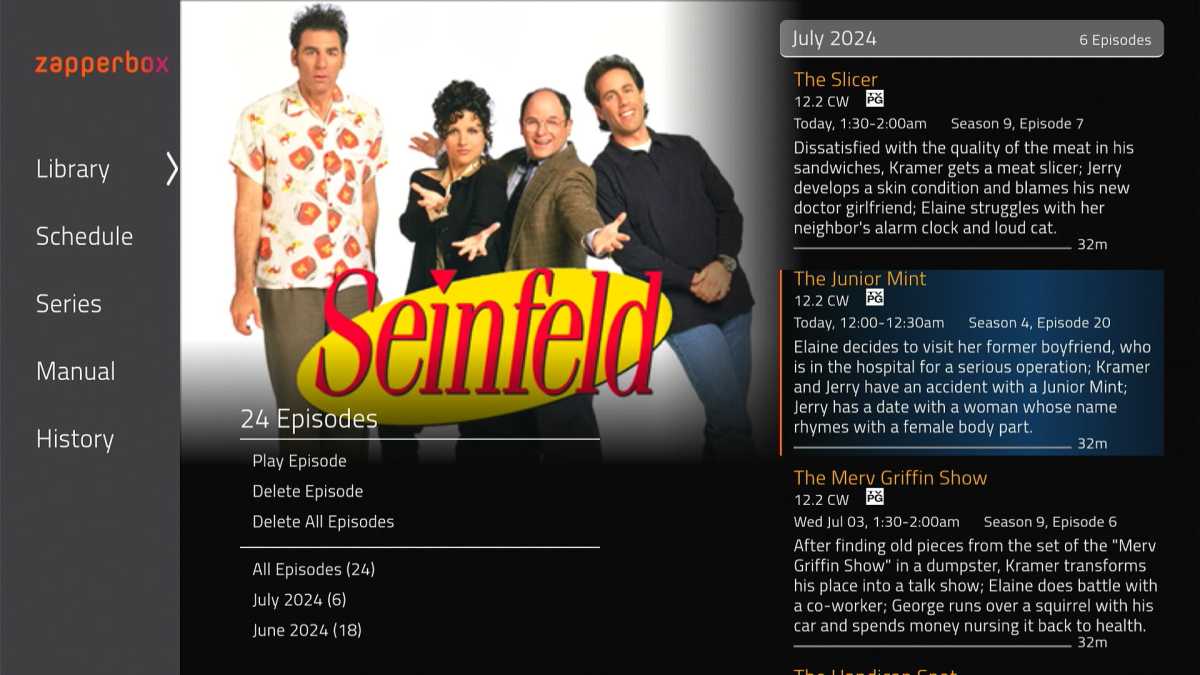
ZapperBox’s program page sorts episodes by air date, not series order.
Jared Newman / Foundry
Tuner management can also be tricky, as you can’t set up a priority list for series recordings. The ZapperBox does warn when you’ve created a tuner conflict for one-off recordings, but it requires picking through a separate “Schedule” menu to weed out other conflicts one-by-one.
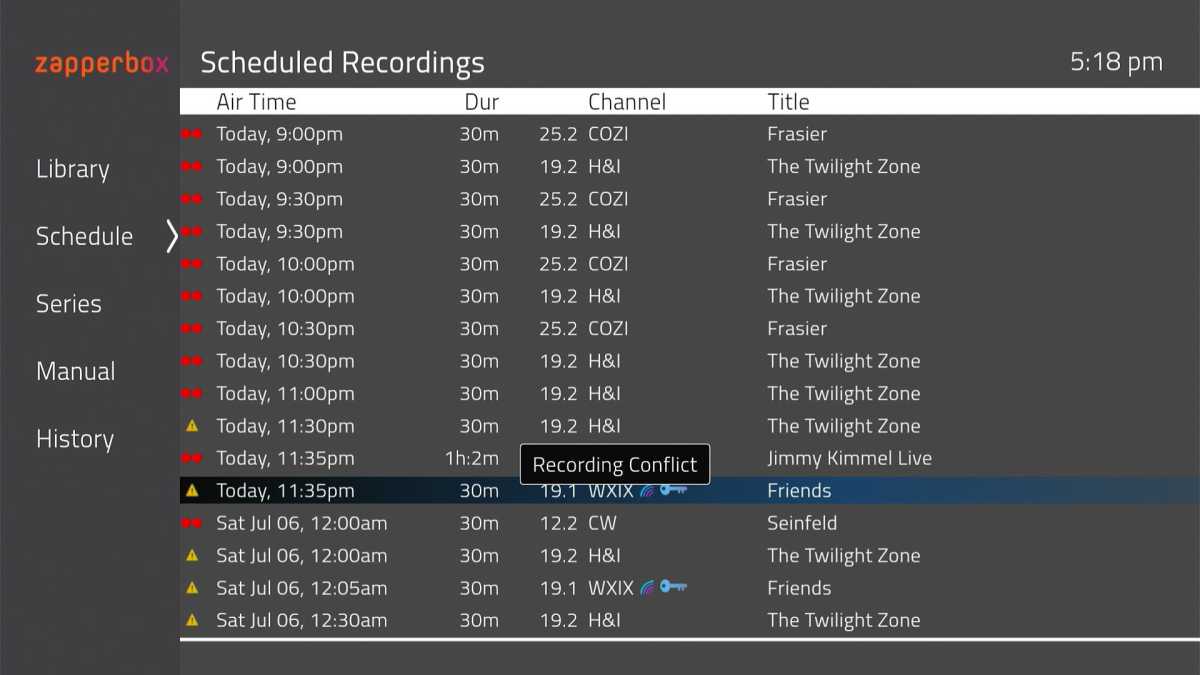
Jared Newman / Foundry
The ZapperBox’s ad-skipping experience could be better as well. The fast forward button works in 30-second increments, while rewind jumps back 10 seconds, and there’s no way to customize either. You get no visual preview when skipping ahead and no markup of commercial breaks, so you’re pretty much flying blind while trying to fast forward through commercials.
The upside is that recordings actually work as expected. Unlike with Tablo’s fourth-gen DVR, I never returned to the ZapperBox after several days to discover it had quietly gone offline and failed to record anything.
ATSC 3.0 support
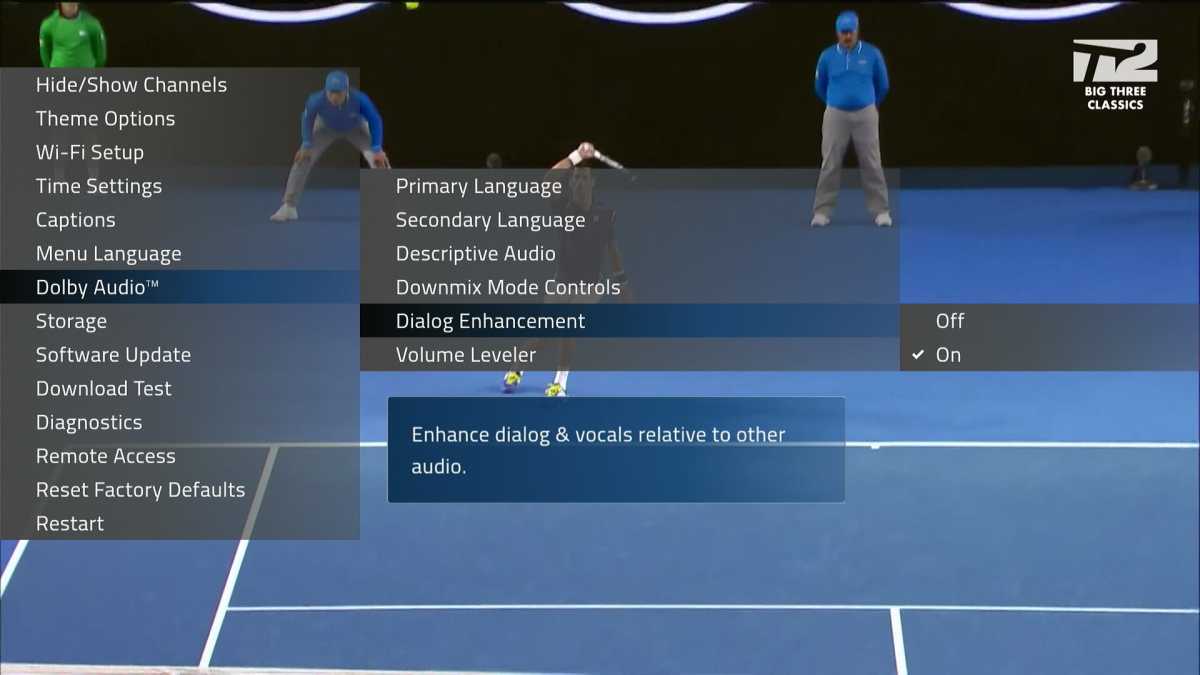
Dialog enhancement is one of ATSC 3.0’s most noticeable features.
Jared Newman / Foundry
ATSC 3.0, also known as NextGen TV, is a new broadcast standard that the industry is pushing as a replacement for the existing ATSC 1.0 standard. It enables a slew of new features for over-the-air TV, including 4K HDR video, on-demand content, additional internet-based stations, dialog enhancement, and Dolby Atmos object-based surround sound.
Many of those features are not widely available yet, so the benefits of ATSC 3.0 today consist mainly of 1080p video on some stations and dialog enhancement on all stations. Here in Cincinnati, the only 1080p stations are those that broadcast at 1080i with ATSC 1.0, and the difference is barely noticeable. Dialog enhancement does make a significant difference and is a welcome improvement.
As more ATSC 3.0 features arrive, the ZapperBox should be able to support them. It’s already capable of playing HDR video—though only my local NBC station offers it—and I have access to one internet-based channel, Sinclair’s T2. The ZapperBox also has a dormant “BA” button, which is supposed to support interactive broadcast apps in a future update.
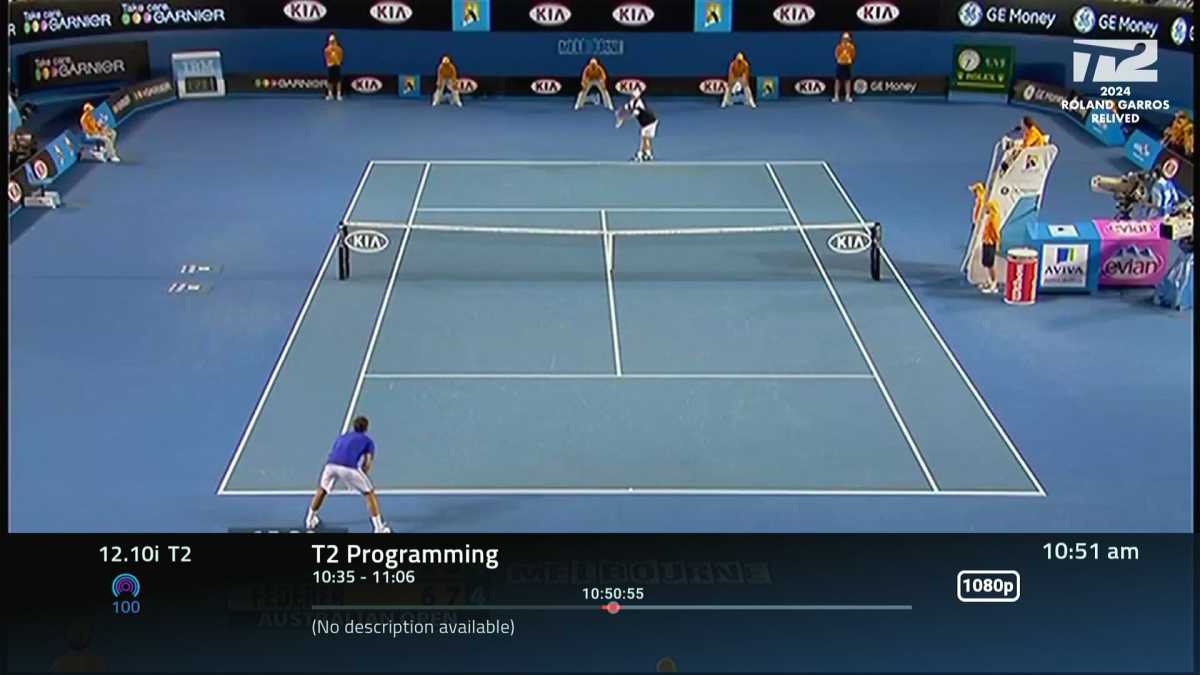
ATSC 3.0 can stream extra channels such, as the Tennis Channel’s T2, directly into your over-the-air guide.
Jared Newman / Foundry
ATSC 3.0 introduces one controversial change: It allows broadcasters to encrypt over-the-air channels, and many of them started doing so in 2023, wreaking havoc on DVR makers’ plans. Fortunately, ZapperBox is certified to support encrypted broadcasts, and an update in April added support for recording encrypted channels.
Still, DRM does leave its mark on the ZapperBox in a couple of ways: You can’t watch encrypted ATSC 3.0 channels without an internet connection, and you’ll never be able export encrypted recordings onto another device for playback. (A future update will let you play unencrypted recordings on other devices, but at present you can only back up recordings to a secondary drive for playback on the ZapperBox itself.)
More on the roadmap
ZapperBox publishes a list of features it expects to add in the future, the most notable of which is multi-room DVR. This will allow users to set up multiple ZapperBox devices, with recordings and tuners shared across each television. The company also plans to add offline playback of encrypted ATSC 3.0 channels, playback support for exported recordings, and apps for accessing ZapperBox content on streaming players.
We only review products based on how they function today, and don’t recommend buying a ZapperBox based on the expectation of unreleased features. But so far, ZapperBox has done a fine job responding to feedback and improving its product with software updates.
Those improvements have already transformed the ZapperBox M1 from a beta product into a solid, plug-and-play DVR, one that can record any over-the-air channel, encrypted or not. While it has room to be even better, there are frustratingly few simple alternatives to recommend in its place.
Editors’ note: This review was originally published on September 13, 2023. The manufacturer has released several software updates since that date, so the product you might purchase today is now very different. We have re-evaulated the Zapperbox M1 accordingly, and this is our opinion as of July 22, 2024.



